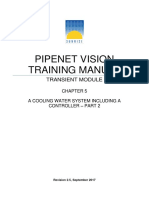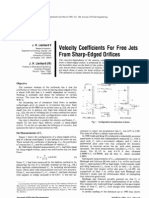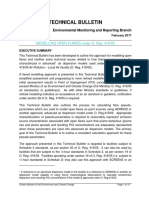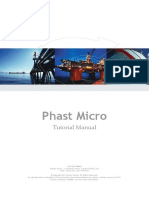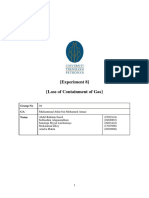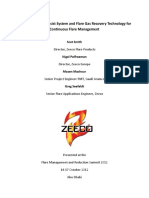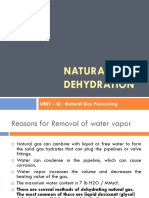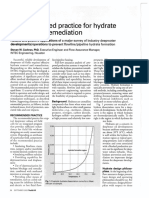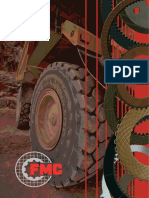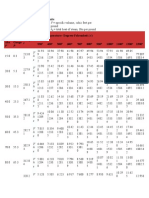Fire Engulfment of LPG Storage Tanks
Fire Engulfment of LPG Storage Tanks
Uploaded by
Khan LalaCopyright:
Available Formats
Fire Engulfment of LPG Storage Tanks
Fire Engulfment of LPG Storage Tanks
Uploaded by
Khan LalaOriginal Title
Copyright
Available Formats
Share this document
Did you find this document useful?
Is this content inappropriate?
Copyright:
Available Formats
Fire Engulfment of LPG Storage Tanks
Fire Engulfment of LPG Storage Tanks
Uploaded by
Khan LalaCopyright:
Available Formats
TOE FIRE ENGULFMENT OF LPG STORAGE TANKS
K Moodie*, K Billinge* and D P Cutler*
A series of fire engulfment trials have been carried out
on uninsulated
tonne and 1 tonne LPG tanks.
The
tanks, having various fill levels, were engulfed by kerosene pool fires.
They were instrumented with thermocouples both internally and externally, pressure transducers and in some instances were supported on load cells.
Data was obtained on heat transfer rates to the total
system and tank contents, the boiling regime, average wall
temperatures, ERV discharge rates and tank failures. The
thermal responses of the tanks were found to be similar to
other data reported in the literature, and well predicted
by a simple computerised model which is described elsewhere.
INTRODUCTION
Whenever highly flammable fluids such as LPG are either stored or transported
in bulk there is the risk that any leak, may, if ignited, result in the
storage vessel becoming engulfed by fire. This, in the case of LPG, may have
particularly serious consequences because it is often stored as a pressurised
liquid at ambient temperature.
Thus if the vessel is heated externally,
causing a rise in internal pressure and a loss in the mechanical strength of
its walls due to the elevated temperatures, it may fail catastrophically and
suddenly release its contents. Such a release may propel fragments of the
vessel over considerable distances. In addition, significant amounts of fluid
may flash to vapour, which if ignited can lead to fire ball behaviour with
associated releases of thermal energy.
Pressure relief valves (PRVs) are therefore fitted to tanks to vent their
contents at a pressure above the maximum working pressure, and at a rate that
will prevent further pressure build up leading to loss of integrity.
The
valves are sized, according to most codes of practice, on the assumption of a
uniform heat flux from the engulfing fire of about 100 kW/m 2 (no account being
taken of non-uniform heating effects, nor of the maximum wall temperatures
likely to be attained).
In order to make realistic assessments of the potential hazards it is
necessary to know the thermal response of storage vessels in a fire engulfment.
This is currently being investigated at the Explosion and Flame
Laboratory of the Health and Safety Executive. Firstly, the development of
theoretical models is being funded which will predict vessel behaviour for a
range of fire engulfment scenarios, as described in (1). Secondly, an
*Health and Safety Executive, Explosion & Flame Laboratory, Harpur Hill,
Buxton, Derbyshire
87
IChemE SYMPOSIUM SERIES No. 93
experimental programme of validation is being carried out in which a range of
tanks of different sizes and different fill levels are being engulfed by
kerosene pool fires.
This paper is concerned with the latter aspect,
particularly the results from tests on
and 1 tonne uninsulated tanks.
There appears to be only a limited amount of similar data currently available
in the literature. The largest fire engulfment test previously undertaken
appears to be that described by Anderson et al (2), in which a 64 tonne
railcar was fire engulfed. Vessel wall temperatures for both inner and outer
surfaces were recorded, together with the bulk liquid and vapour temperatures,
the average heat flux from both the fire and the PRV flare. Measurements were
also made of the liquid level in the tank and the thermal radiation from the
PRV flare. The vessel failed catastrophically some 24.5 minutes into the test
with an estimated 40% of the LPG still remaining in the tank. Fragments from
the vessel were reported at considerable distances from the test site. The
maximum wall temperature near the point where the vessel started to fail was
of the order of 650C and the internal pressure was 24.1 bar at failure.
Similar tests on smaller capacity vessels
tonnes) have been reported by
the Federal Institute for Material testing, Berlin (3). Three fire tests were
undertaken for LPG stored in accordance with the appropriate DIN standard, and
again vessel skin temperature variations with time were recorded.
In all
these tests tank failures occurred within 7 to 12 minutes from the beginning
of the fires, depending upon the initial temperature of the LPG.
Extensive laboratory simulations and theoretical predictions have been
undertaken by Venart et al (4, 5 and 6). An electrically heated 40 1 capacity
cylindrical pressure vessel was used, that was fitted with observation windows
at both ends and contained Freon 11 or Freon 12 to simulate the LPG loading.
It was instrumented so that various aspects of the thermal response could be
studied and compared with theoretical predictions.
Nyland (7) has made
extensive theoretical and experimental studies of the behaviour of pressurised
gas process vessels subject to both total and partial fire engulfment. His
predictions of vessel failures within a relatively short time after the
beginning of the fire were confirmed experimentally.
2
EXPERIMENTAL FACILITIES
The fire engulfment trials were carried out by supporting the tanks ever a
bund and exposing them to pool fires of kerosene contained within the bund.
Five tests in total were undertaken, two with a 1/4 tonne tank and three with
a 1 tonne tank.
The tanks were re-used after each test, but only after
carefully checking that they had not been weakened excessively in the previous
fire.
In the second 1/4 tonne test the tank failed catastrophically as a
result of a PRV malfunction.
3
THE TEST FIRE AND BUND DESIGN
The bund, which was used for all of the tests, consisted of a firebrick
enclosure some 4m long by 2.4m wide by 0.6m deep. A lm high windbreak wall
surrounded the bund at a distance of lm from it. The windbreak ensured that
flame of at least 1 m thickness engulfed the tank under normal wind
conditions.
The test tanks were supported on firebrick piers so that the
bottom of a tank was flush with the top of the pool walls. When testing the 1
tonne tanks four load cells were also fitted so that the weight of the vessel
and its contents could be recorded continuously throughout a trial.
The burning rate of kerosene in the bund was approximately 0.64 1/s.
88
Hence
IChemE SYMPOSIUM SERIES No. 93
for these tests, having an intended duration of 30 minutes, a kerosene pool
120mm deep was necessary. The fuel was ignited electrically, having first of
all being made more sensitive to ignition by the addition of 10 litres of
petrol over its surface. A fluorocarbon foam fire extinguishing system was
provided, which could be operated remotely and which would extinguish a fire
within 45 seconds.
4
TANK INSTRUMENTATION
Tank wall temperatures were measured by eight stainless steel chromel-alumel
thermocouples welded to the outer surface of a tank and positioned at two
vertical planes equi-distant from the tank ends, as shown in Fig la. The bulk
temperatures of the liquid propane and the vapour were measured by three
thermocouples mounted vertically inside the tank, as shown in Pig lb. PRV's
were fitted to the tops of the tanks; their sizes were those recommended by
the LPGITA code of practice (8). Short (lm) flare pipes were fitted to the
PRV outlets. The relief valve assemblies were protected from the fire by an
insulating blanket. Internal pressures were measured by a pressure transducer
connected to a pressure tapping from the bottom of a tank.
The mass of the 1-tonne tank and its contents was measured using a four-point
load cell weighing system with preamplifier and temperature compensation
system enclosed in a waterproof container. The load cells and preamplifier
were positioned on the floor of the bund and were submerged in 300mm of water.
All transducer signals were carried out of the fire zone by means of mineral
insulated multicore cables.
The pressure transducers, thermocouples and
weighing system were connected to chart recorders and an automatic data logger
situated within a control room some 120 metres from the bund. The data logger
sampled each transducer every 10 seconds.
All of the fire tests were
videotaped and still photographed. The test parameters and test conditions
are summarised in Table 1.
5
TEST PROCEDURE
The test procedure was to connect up the instrumentation and data logging
system, fit the PRV, fill the tank to the required level, fill the bund with
kerosene, start the data recording system then ignite the fire. Typically, a
fire took up to 11/2-2 minutes to become fully established, after which the
vessel contents would begin to heat up. The PRV's then opened within the
following 2-5 minutes, depending on vessel size, fill level and initial
temperature.
In most tests successive PRV venting then occurred until the
tanks were emptied of LPG and the vapour pressure fell below the relief
pressure.
6
RESULTS AND DISCUSSION
All four successful tests followed a similar pattern of behaviour. Once a
fire was established the tank wall temperatures began to rise.
Those
thermocouples attached to tank walls adjacent to the vapour space rose at a
much quicker and approximately linear rate compared with those attached to
walls adjacent to the liquid space. The latter rose to a plateau level before
rising further. This behaviour is consistent with the results reported in (2)
and reflects the fact that the convective heat transfer coefficient from the
tank wall to the liquid is much higher than that to the LPG vapour. Once the
PRV began to discharge fluid at a nearly constant internal pressure, the liquid
outer wall temperature remained just above the corresponding boiling point,
until sufficient liquid had boiled off to expose the thermocouples. The
89
IChemE SYMPOSIUM SERIES No. 93
duration of the 'plateau' therefore varies with fill level and discharge rate.
In the four successful tests this lasted between 1-14 minutes, after which all
wall temperatures rose steadily to reach peak values similar to those of the
vapour walls before the tests were terminated.
The maximum wall temperatures recorded by individual thermocouples were in the
region of 600-800C. These were considered to be consistent with the assumed
flame emissivity of 0.56, the wall F factor, and the recorded average flame
temperatures of a typical kerosene pool fire, as discussed by Roberts et al
(9) for earlier engulfment tests. Typical flame temperature measurements, are
shown in Fig 2, and illustrate that an average flame temperature of 900-950C
is typical for these tests, peaking at values of 1000C.
As these
temperatures were well below the adiabatic flame temperature they indicate
that the kerosene fires were deficient in oxygen, which was also suggested by
the very yellow flames and copious smoke being produced.
The internal pressures in all cases rose to the relief valve set pressures
within 3-5 minutes from the commencement of the fire. After cycling at least
twice the PRV's remained open in four of the five tests until the internal
pressure was eventually down to atmospheric or thereabouts. This fail safe
behaviour was, upon subsequent examination of the valves, attributed to fire
damage to the valve seats and to a weakening of the valve springs. It was
also observed that at no time did the internal pressure remain at a level
likely to cause tank rupture consistent with a reduction in tensile properties
of the vessel wall due to the elevated temperatures. Thus failures of the
type predicted in (7) were not to be expected at all during the latter stages
of the fire engulfment.
6.1
1/4 TONNE TANK
Two tests were undertaken with this size of tank, both 40% full of propane
(200 1 ) , but only one test was completed without damaging the tank.
A
representative outer wall temperature for the vapour space and also one for
the liquid space outer wall are shown in Fig 3. The bulk internal temperatures recorded by the three internal thermocouples T,M and B are shown in Fig
4. The internal pressure is shown in Fig 5.
These results show that the average upper wall temperature rose almost
linearly, starting after 90 s from ignition, to reach a value of around 700C
at 8 minutes. The lower wall temperature, after a similar delay, rose in
180 s to a plateau value of 90C, and remained so for a further 120 s, before
rising linearly to 500C after 8 minutes. The bulk temperature of the liquid
propane as recorded by thermocouples M & B reached 47C after 180 s, and
remained more or less constant for a further 120 s, before rising at an
increasing rate to reach 450C after 8 minutes. The bulk vapour thermocouple
reached 100C in 180 s and thereafter rose to reach 150C after 300 s, and
520C after 8 minutes.
This sequence of variations is similar to those obtained for larger vessels as
reported in (2) and (3) and tend to confirm the proposition that the majority
of the heat is transferred to the liquid propane by nucleate boiling, both
before and after the PRV has opened. Thus from Figs 3 and 4 the estimated
inner temperature wall, allowing for the wall temperature gradient, can be
seen to be always higher than the bulk saturated liquid temperature (the
latter following closely the saturation curve for liquid propane). Thus at
the moment venting begins Tw-Tsat has a value of some 20C.
90
IChemE SYMPOSIUM SERIES No. 93
This is a higher value than the corresponding one used by Ramskill and Hunt
(1) to nodel the nucleate boiling phase of heat transfer for the same heat
flux, based upon the Rohsenow pool boiling correlation. One explanation for
the difference may be the development of a two-phase boundary layer due to
both the rapid increase in the number of nucleation sites and the vessel wall
curvature. Such phenomena are reported to exist in (5) and may indicate the
need for different correlation coefficients, but which also do not effect
unduly the time response predictions for the PRV opening.
The bulk vapour and liquid temperatures show that some thermal stratification
can exist within the vessel's contents. Thus at the moment venting begins the
vapour is superheated by as much as 50K, as shown in Fig 4. This superheat
falls immediately after PRV opening to approach saturation as liquid is boiled
off. Similar effects were also reported in (2).
The internal pressure curve, Fig 5, shows that the PRV first opened 180 s
after ignition, which agrees well with the predicted time (1). Successive
openings of the PRV occurred at reduced pressures until the valve failed open
after 6 minutes.
The total time that the valve was open during this 3-5
minute period was 88 seconds, during which approximately 46 kg of propane were
discharged, at an average flow rate of 0.52 kg/s. This is a slightly lower
rate than the choked vapour flow rate of the PRV fitted (0.70 kg/s), which
when considered in the light of the 1 tonne results discussed later, suggests
initially at any rate, that there may have been some liquid carry over into
the vent system. This would imply that a considerable amount of two-phase
swelling, occurs when the PRV opens. If so then it does not appear to allow
the liquid wall temperature to rise and initiate film boiling, as no
appreciable liquid wall temperature increases were apparent until the liquid
level had fallen below the thermocouples. This PRV/liquid interaction has
been suggested .as a mechanism for obtaining film boiling (6), but these
results suggest either that a larger vent area/liquid surface area ratio is
necessary before it will happen in this case, or scaling effects are becoming
significant.
The average rates of heat transfer into the propane and tank wetted wall up to
the onset of venting (constant mass) were calculated from the bulk temperature
and pressure data. Changes in specific heat, thermal expansion etc were taken
into account. It will be observed that the average rate of heat input into
the propane was 123 kW before venting. This corresponds to a heat flux of 73
kW/m2 assuming all of the heat to be transferred to the liquid propane via the
wetted surface. The heat flux into the tank wall for the corresponding period
was 24 kW/m2. Thus giving a total heat flux of 97 kW/m 2 to compare with the
value (100 kW/m2) recommended for valve sizing.
The average heat flux into the system during boil-off was calculated from the
mass discharge rates to be 80 kW/m2.
These calculations show that the critical heat flux, Butterworth (10)
necessary to take the boiling mode into film boiling is not reached, and
provide a further indication that nucleate boiling predominates.
6.2
1/4 TONNE VESSEL RUPTURE
One test with a 40% fill provided the opportunity to study the consequences of
a catastrophic failure, because the PRV, after first opening correctly, failed
to do so subsequently. Consequently both the internal pressure and the vapour
space wall temperature rose uncontrollably. The fire extinguishing system was
91
IChemE SYMPOSIUM SERIES No. 93
not used and the vessel ruptured when the internal pressure reached 35 bar and
the maximum wall temperature was 600C.
The resultant blast scattered
fragments of the pressure relief system up to 170 m, but the bulk of the
vessel remained within 20 m of the test site. The fireball was estimated to
have had a maximum diameter of 21 m and to have lasted for 1-2 seconds. The
PRV was examined after the test but the reasons for the failure to operate
correctly have not been established.
A subsequent metallurgical examination of the vessel remains showed that there
had not been any incipient cracks of significance and that the membrane wall
had deformed and ruptured along the top of the vessel, (presumably where the
wall temperature was at its highest value).
This was consistent with an
excessive hoop stress in the vessel wall rather than stresses from potential
stress raisers such as a pipe fittings or access holes. The position of the
initial failure would also seem to rule out the possibility of stresses from
the thermal gradient in the wall at the liquid vapour interface being a
significant cause of failure. Hence it is suggested that the burst pressure
may be calculated from thick walled cylinder theory (11) to give:
where Pt> is the burst pressure, K the outside diameter/inside diameter ratio
of the cylinder and
are respectively the yield strength and ultimate
tensile strength of the vessel material at the elevated temperature T. Thus
taking the maximum wall temperature as the recorded value of 600C and substituting the appropriate strength properties, the calculated burst pressure is
38 bar. This is within 8% of that observed. Furthermore if this formulae is
taken as a criteria for vessel failure then it can be shown that all the other
tests either depressurised safely or were stopped before reaching unsafe
temperatures. Application of equation (1) to the data of (2) and (3) will
predict all of the burst pressures with less than a 18% error. The greater
inaccuracy is probably due either to doubt about the appropriate strength
properties or in some cases the point where rupture began.
6.3
1-TONNE TANK
Three trials were undertaken using fill ratios of 40%, 80% and 20% respectively. The same type of data was recorded as in the previous tests but in
addition the tank was weighed continuously.
The vapour and liquid wall
temperatures are shown in Figs 6 and 7 respectively for all three fills. The
bulk liquid and vapour temperatures are shown in Fig 8, the internal pressures
in Fig 9, and the weight losses in Fig 10.
The results from all three tests showed the same trends as the previous
tonne test. The fires again took
minutes to establish themselves,
after which both vapour and liquid wall temperatures rose as previously but at
slower rates. The upper surface temperatures rose at more or less the same
rates in the 40% and 20% fill tests to reach 600-700C in 12-15 minutes from
ignition. In the case of the 80% fill the rate of rise was slower and about
the same as that of the liquid space wall temperature. This was because the
thermocouples were close to the liquid level until after the PRV had vented
some of the contents. The lower surface temperatures, after a 60-90 s delay,
rose to their plateau temperatures after 1(20%), 11(40%), and 18(80%) minutes.
92
iChemE SYMPOSIUM SERIES No. 93
before rising to peak at values in excess of 500C at which time the tests
were terminated.
Although the plateau temperatures followed the expected
pattern, (apart from the 20% fill test, for which the thermocouples were
barely below the liquid level when the test began), the values of
for the two other tests were higher than previously, but were nevertheless
more typical of nucleate than film boiling.
The bulk liquid and vapour temperatures shown in Fig 8 were as expected. The
liquid region thermocouple followed approximately the saturation curve during
venting until it was uncovered, whilst the vapour spaces became superheated
within relatively short times. The 20% fill showed the maximum superheat of
150C, just prior to venting. The superheats again fell towards saturation as
the PRV's opened and liquid boil off began.
The internal pressures, Fig 9, showed that the 80% fill vented first after
226 s when the pressure was 15.2 bar. There then followed a rapid sequence of
three further valve operations before a final opening after 264 s. Thereafter
it just coped with the flow of heat into the tank, the pressure slowly rising
to a peak of 15.5 bar after 10 minutes, then slowly decaying until all of the
propane had vented after 24 minutes. The 40% fill began venting after 262 s
at a pressure of 13.8 bar. The valve remained open for the next 6 minutes,
with the propane burning in a 8-10 m long flare. After 616 s the valve closed
at 11.1 bar pressure. The valve reopened 12 s later at 12.6 bar pressure and
remained so until all the propane had been ejected after 19 minutes. The 20%
fill began venting after 297 s at a pressure of 17.1 bar. There then followed
a sequence of nine opening and closing operations until after 6 mins 28 sees
it remained open. All of the propane was exhausted after 13 minutes.
Heat flux calculations were carried out, as described previously, and the
results are summarised in Table 2. The average heat fluxes into the propane
were similar to that obtained for the 1/4 tonne test, apart from the low value
of 33 kW/m2 for the 20% fill. Although the total average heat fluxes both
before and after venting are very similar. The lower heat fluxes in the case
of the 20% fill may have been due to the tank being only partially engulfed,
as the wind speed was exceptionally high during this test. These values again
illustrate the fact that the critical heat flux for film boiling is not
reached.
6.4
PRV DISCHARGE RATES
The tank weighed 0.99 tonnes and contained initially 870 , 420 and 160 kgs of
propane to correspond with the three fill levels of 80, 40 and 20% respectively. The load cell output, Fig 10, confirmed that the times for the PRV's
to first open were as obtained from the internal pressures. They also showed
the initial thrust of the jet flare which was different in all three cases and
possibly indicative of the different degrees of valve opening that may occur
with nominally similar valves. The slopes of the curves represent the mass
flow rates during discharge and show that in all cases the maximum discharge
rate occurs during the first opening of the valves. Maximum (initial) and
average valves for the three tests are also given in Table 2. These confirm
the suggestion of two phase discharge discussed previously in connection with
the 1/4 tonne results.
The actual PRV fitted to the tank had a flow rate of 1.16 kg/s measured with
air at 15C and 16.6 bar pressure. Thus the effective critical valve area,
A E , as determined from the choked mass flow equation for compressible flows is
given by:-
93
IChemE SYMPOSIUM SERIES No. 93
where m is the mass flow rate, R the gas constant, T 0 the initial temperature,
Z the compressibility factor, P 0 the initial pressure, and
the specific
heat ratio.
v
This gives a value for
of
for this particular valve.
Assuming that propane is vented at a similar pressure through the same
effective area, then from the bulk vapour temperatures immediately prior to
venting, the maximum propane vapour flow rates, (using a compressibility
factor of .75 as given by Sallet (10)) are for descending fill levels, 1.04,
0.88 and 0.97 kg/s. These may be compared with the maximum and average values
shown in Table 2. It will be observed that in all three tests there appears
to be some high quality two-phase flow or droplet carry over during the first
discharge of the PRV. This is not unexpected with the 80% fill, as the vessel
is almost liquid locked just prior to venting and the PRV is only just able to
cope with the boil off rate as the pressure trace shows.
It is perhaps
surprising in the 20% fill case, especially as the valve throat area to liquid
surface area is relatively small. One possible explanation may be that in
this case the valve lifts further initially giving a larger effective throat
area.
The average mass flow rates are slightly less than the choked flow values, and
this is probably due to the increasing vapour temperature not accounted for in
these comparisons. The results do however illustrate that the performance of
an actual valve can be predicted reasonably well from the standard
compressible flow equations, as used in reference (1).
7
CONCLUSIONS
The test data obtained from fire engulfment tests on two sizes of tanks
compared favourably with other fire engulfment data reported in the
literature and was shown (1) to agree with theoretical predictions.
The burst pressure of a 1/4 tonne tank was reasonably well predicted from
its material strength properties at elevated temperatures.
The two tank sizes and different initial fill levels all responded to the
fire engulfment in a similar manner, differing only in their time scales.
The maximum wall temperatures occurred in the vapour space walls and were
of the order of 600-800C when the tests were stopped.
Usually the PRV's operated satisfactorily and prevented excessive
pressures from building up. However the fact that they remained open
towards the end of a test may have been instrumental in preventing vessel
failure.
Further information is required to help understand the boiling behaviour
of the liquid, to identify the appropriate heat transfer correlations,
and to help assess the quality and mass flow rates of propane discharging
through PRV's A more comprehensive series of tests on a 5 tonne tank are
therefore to be undertaken shortly in order to provide additional data.
94
IChemE SYMPOSIUM SERIES No. 93
8
REFERENCES
(1)
Ramskill, P K and Hunt, D L M "The behaviour of tanks engulfed in fire
- The development of a compuer programme".
Symposium Assessment &
Control of Major Hazards, UMIST, April 1985.
(2)
Anderson, C et al "The effects of a fire environment on a rail tank car
filled with LPG". US Dept of Trans. Rept No FRA-OR&D 75-31, 1974.
(3)
Drost, B et al "Failure mechanisms of propane tanks under thermal
stresses including fire engulfment", Int. Conf. Transport & Storage of
LPG & LNG, Brugge. 1984.
(4)
Sousa, A C M and Venart J E S "Thermal modelling of LPG rail tank cars
exposed to fire environment",
4th Int. Conf. on Mathematical
Modelling, Zurich, 1983.
(5)
Venart, J E S et al "Experiments on the Physical modelling of LPG tank
cars under accident conditions". Int. Conf. Transport & Storage of LPG
and LNG, Brugge. 1984.
(6)
Venart, J E S, Sousa, A C M ,
Aydemir, N U "Transient thermal
stratification in heated partially filled horizontal cylindrical
tanks", ASME/AIchE Nat. Ht. Trans. Conf. Niagara Falls 1984.
(7)
Nyland, J "Fire survival of process vessels containing gas". IChemE
Symp Series 85, Chester 1984.
(8)
LPGITA Code of Practice 1, Installation and Maintenance of bulk LPG
storage. Liquified Petroleum gas industry technical association, UK,
1974.
(9)
Roberts, A F et al "Fire engulfment trials with insulated LPG tanks".
4th Int. Conf. Loss Prevention in the Process Industries. IChemE Symp.
Series 82 (1983).
(10)
Butterworth, D B & Hewitt G F, "Two-phase flow and heat transfer",
Oxford University Press 1977.
(11)
Nichols, R W "Pressure vessel engineering technology", Applied Science
Publishers Ltd, 1971.
(12)
Sallet, D W "Sizing of pressure relief valves for pressure vessels used
in the transport of liquified gases", ASME Paper No 78-WA/HT-39, 1978.
ACKNOWLEDGEMENTS
The authors wish to thank the Director, Research and Laboratory Services
Division of the Health and Safety Executive for permission to publish.
(c) Crown Copyright
95
IChemE SYMPOSIUM SERIES No. 93
TABLE I : - I n i t i a l conditions, both tank sizes
TABLE 2 : - Heat Fluxes and discharge rates
96
IChemE SYMPOSIUM SERIES No. 93
97
IChemE SYMPOSIUM SERIES No. 93
98
IChemE SYMPOSIUM SERIES No. 93
99
IChemE SYMPOSIUM SERIES No. 93
100
IChemE SYMPOSIUM SERIES No. 93
101
IChemE SYMPOSIUM SERIES No. 93
102
IChemE SYMPOSIUM SERIES No. 93
103
IChemE SYMPOSIUM SERIES No. 93
104
IChemE SYMPOSIUM SERIES No. 93
105
IChemE SYMPOSIUM SERIES No. 93
106
You might also like
- Pumps Problems 20 ItemsDocument10 pagesPumps Problems 20 ItemsDexter Contawe87% (23)
- John Deere Row Crop Tractor Inspection 8000 SeriesDocument4 pagesJohn Deere Row Crop Tractor Inspection 8000 SeriesPedro PalenciaNo ratings yet
- Fine Tune Relief Calculations For Supercritical FluidsDocument10 pagesFine Tune Relief Calculations For Supercritical FluidsPeter PerezNo ratings yet
- Defence: The Las Tlineo FDocument5 pagesDefence: The Las Tlineo FMuhamad Nur HusenNo ratings yet
- Creating and Configuring A BACnet Network With b3 BACnet Devices Tutorial GuideDocument212 pagesCreating and Configuring A BACnet Network With b3 BACnet Devices Tutorial GuideDGG50% (2)
- Theoretical and Observational Assessments of Flare EfficienciesDocument7 pagesTheoretical and Observational Assessments of Flare EfficienciesArcangelo Di TanoNo ratings yet
- Kayser Shambaugh (1991)Document15 pagesKayser Shambaugh (1991)Process LibraryNo ratings yet
- Commonly Missed Overpressure Scenarios - SmithBurgess, Wahid WakilDocument40 pagesCommonly Missed Overpressure Scenarios - SmithBurgess, Wahid WakilJacekNo ratings yet
- Dry VRU Training Guide 2009 R2Document52 pagesDry VRU Training Guide 2009 R2lucashck100% (2)
- THBI-10 Mellachevron E v1 1Document38 pagesTHBI-10 Mellachevron E v1 1Marwan AhmedNo ratings yet
- Transient - Chapter 5 - Cooling Water System Part 2Document77 pagesTransient - Chapter 5 - Cooling Water System Part 2வி.சுரேஷ் குமார்No ratings yet
- Flare and Disposal System DG-3575Document25 pagesFlare and Disposal System DG-3575Michael J. BaneNo ratings yet
- Onshore and Offshore: Echnical PresentationDocument66 pagesOnshore and Offshore: Echnical PresentationAnonymous 4MwmDaNbNo ratings yet
- PSV Sizing For Fire Cases Is A Dynamic Model Worth The TimeDocument9 pagesPSV Sizing For Fire Cases Is A Dynamic Model Worth The TimeOlumuyiwa FasehunNo ratings yet
- 2010AFRC Elevated Flare Ignition PaperDocument21 pages2010AFRC Elevated Flare Ignition Paperac2475100% (1)
- Velocity Coefficients For Free Jets From Sharp-Edged OrificesDocument5 pagesVelocity Coefficients For Free Jets From Sharp-Edged OrificesMarco Batista XandóNo ratings yet
- Flare Selection and Sizing (Engineering Design Guideline) : KLM Technology GroupDocument19 pagesFlare Selection and Sizing (Engineering Design Guideline) : KLM Technology GroupDavid GlawsonNo ratings yet
- Gas Explosion Scale Offshore Modules Using Fuel/air Clouds Experiments in I:33 and 1:5 Separator and Compressor Stoichiometric HomogeneousDocument9 pagesGas Explosion Scale Offshore Modules Using Fuel/air Clouds Experiments in I:33 and 1:5 Separator and Compressor Stoichiometric Homogeneousigor VladimirovichNo ratings yet
- GP 44-70Document54 pagesGP 44-70akohNo ratings yet
- Risk Based Approach Facility Siting Addressing Fires Impacting Process Plant Permanent and Portable Buildings 2017Document14 pagesRisk Based Approach Facility Siting Addressing Fires Impacting Process Plant Permanent and Portable Buildings 2017joleen100% (1)
- Phast: Tutorial ManualDocument42 pagesPhast: Tutorial ManualNitesh Kirnake100% (1)
- Process InstrumentationDocument71 pagesProcess InstrumentationPrasanna kumar subudhiNo ratings yet
- Evaluate Pressure Relief SystemDocument10 pagesEvaluate Pressure Relief SystemayoungaNo ratings yet
- Modeling and Simulation of Fixed Bed Adsorption Column: Effect of Velocity VariationDocument15 pagesModeling and Simulation of Fixed Bed Adsorption Column: Effect of Velocity VariationemebusamuelNo ratings yet
- PrecautionsDocument15 pagesPrecautionsyajur_nagiNo ratings yet
- Flares CFDDocument15 pagesFlares CFDRicardo BecNo ratings yet
- MODELLING OPEN FLARES CanadaDocument19 pagesMODELLING OPEN FLARES Canadahk168No ratings yet
- VOC Emissions From Oil and Condensate Storage TanksDocument108 pagesVOC Emissions From Oil and Condensate Storage TanksAlexander KnightNo ratings yet
- Phast Micro: Tutorial ManualDocument34 pagesPhast Micro: Tutorial ManualmelancholicNo ratings yet
- Horizontal KO Pot V1.2Document6 pagesHorizontal KO Pot V1.2hk168No ratings yet
- Centrifugal Sand Separators PDFDocument4 pagesCentrifugal Sand Separators PDFMilena Lemus Fonseca0% (1)
- NEMA Standards Publication 250-1997: Enclosure TypesDocument5 pagesNEMA Standards Publication 250-1997: Enclosure TypesRock'nrollGuysNo ratings yet
- Tank Explosion For WaterDocument5 pagesTank Explosion For WaterRobert MontoyaNo ratings yet
- Reliefandblowdown SudyDocument35 pagesReliefandblowdown Sudysivainduri100% (1)
- Optimization of Operational Condition of A Condensate Stabilization Plant and Investigation of Effective Parameters On Reid Vapor Pressure (RVP)Document2 pagesOptimization of Operational Condition of A Condensate Stabilization Plant and Investigation of Effective Parameters On Reid Vapor Pressure (RVP)okoro matthewNo ratings yet
- Vent Dispersion CalcDocument9 pagesVent Dispersion CalcPeddy Nesa0% (1)
- Relief SystemDocument24 pagesRelief SystemFarhanSaatNo ratings yet
- FTPDocument12 pagesFTPaymansafetyNo ratings yet
- Gp030101 - Com Upstream Piping Component Selection and System Design (Version 12.0.0 JUN 2018)Document88 pagesGp030101 - Com Upstream Piping Component Selection and System Design (Version 12.0.0 JUN 2018)Ammar KmkNo ratings yet
- Orifice CalculationDocument12 pagesOrifice CalculationAnjum NaveedNo ratings yet
- FMRL Oxidizer Classification Research Project ReportDocument94 pagesFMRL Oxidizer Classification Research Project ReportkdsessionsNo ratings yet
- Relief System Sizing For RunawayDocument13 pagesRelief System Sizing For RunawayShiva Kumar S M100% (1)
- Relief PDFDocument0 pagesRelief PDFscribpenumakaNo ratings yet
- Exp 8 - Loss of Containment of GasDocument18 pagesExp 8 - Loss of Containment of GasSanjeev NehruNo ratings yet
- 11 07 Bonding GroundingDocument3 pages11 07 Bonding GroundinggeeforeNo ratings yet
- ReycoDocument45 pagesReycohacenescribdNo ratings yet
- Pump NPSHDocument3 pagesPump NPSHDurjoy ChakrabortyNo ratings yet
- Radiation Heat TransferDocument39 pagesRadiation Heat TransferIsmail MughalNo ratings yet
- Static ElectricityDocument4 pagesStatic ElectricityMD. Sharifuzzaman JoyNo ratings yet
- Flame Arrestor White Paper en 5364202Document15 pagesFlame Arrestor White Paper en 5364202ksvvijNo ratings yet
- Smokelesss Flare - Air AssistsedDocument19 pagesSmokelesss Flare - Air Assistsedvasu100% (1)
- Toxic Release and Dispersion ModelDocument49 pagesToxic Release and Dispersion ModelAin SyuhadaNo ratings yet
- Toxic Release and Dispersion ModelsDocument42 pagesToxic Release and Dispersion ModelsAbhijit NathNo ratings yet
- Natural Gas DehydrationDocument12 pagesNatural Gas DehydrationSagar DadhichNo ratings yet
- Hazardous AreasDocument118 pagesHazardous AreaskamalNo ratings yet
- Ground Flares - Out of Sight Out of MindDocument8 pagesGround Flares - Out of Sight Out of MindNurul Atiqah Ahmad Kamal100% (1)
- Understanding Heat Flux Limitations CCTI 2010Document8 pagesUnderstanding Heat Flux Limitations CCTI 2010B rgNo ratings yet
- Understanding Atmospheric Storage TanksDocument10 pagesUnderstanding Atmospheric Storage Tanksflashkickerazar100% (1)
- 2003 Cochran RP Hydrate Control Remediation PDFDocument8 pages2003 Cochran RP Hydrate Control Remediation PDFArsénioNo ratings yet
- W6 Toxic Release and Dispersion Models UlearnDocument61 pagesW6 Toxic Release and Dispersion Models UlearnFakhrulShahrilEzanieNo ratings yet
- Emergency Relief System Design Using DIERS Technology: The Design Institute for Emergency Relief Systems (DIERS) Project ManualFrom EverandEmergency Relief System Design Using DIERS Technology: The Design Institute for Emergency Relief Systems (DIERS) Project ManualRating: 4 out of 5 stars4/5 (1)
- Safety: On The Adequacy of API 521 Relief-Valve Sizing Method For Gas-Filled Pressure Vessels Exposed To FireDocument17 pagesSafety: On The Adequacy of API 521 Relief-Valve Sizing Method For Gas-Filled Pressure Vessels Exposed To FireAdarsh SreekumarNo ratings yet
- ERIBA TouringDocument49 pagesERIBA TouringMaría FernándezNo ratings yet
- pr9903 - Specification For Building and Structural WorksDocument80 pagespr9903 - Specification For Building and Structural Workskidi mollaNo ratings yet
- Jit & TocDocument5 pagesJit & Tochraju_6100% (1)
- SOPDocument2 pagesSOPAlekhya Chunduru100% (1)
- SCM Sof Smop 56 Is 0321 0207 - 26110207 - 01Document1 pageSCM Sof Smop 56 Is 0321 0207 - 26110207 - 01Reno Reza GumilangNo ratings yet
- Spider CloudDocument2 pagesSpider Cloudaa1cc2No ratings yet
- Case Study - Auditorium (Vishnudas Bave, Mumbai)Document1 pageCase Study - Auditorium (Vishnudas Bave, Mumbai)Jiya Robert100% (1)
- 2020 FMC Catalogue PDFDocument197 pages2020 FMC Catalogue PDFsergio melgarejoNo ratings yet
- 1 - Crude Oil Treatment - SeparationDocument85 pages1 - Crude Oil Treatment - SeparationHaider100% (12)
- StoichiometryDocument34 pagesStoichiometryvanditNo ratings yet
- 4.4.2.3 Moment Amplification For A Sway Member For A Sway Member, The Design Bending MomentDocument2 pages4.4.2.3 Moment Amplification For A Sway Member For A Sway Member, The Design Bending MomentAhmedNo ratings yet
- Dorian Tool Threading Grooving and API CatalogDocument88 pagesDorian Tool Threading Grooving and API CatalogEnrique Horta100% (1)
- ASTM-D3424-Color Fastness in SunlightDocument5 pagesASTM-D3424-Color Fastness in SunlightTushar NathNo ratings yet
- AnthropometryDocument2 pagesAnthropometryPia louise RamosNo ratings yet
- Specific Registration Requirements For Mechanical & Electrical Workhead (Me)Document5 pagesSpecific Registration Requirements For Mechanical & Electrical Workhead (Me)binoyraj2010No ratings yet
- TitleDocument4 pagesTitleArvin LibutanNo ratings yet
- Polypoxy EN: High Build Phenol Novolac Epoxy Resin Based Protective CoatingDocument2 pagesPolypoxy EN: High Build Phenol Novolac Epoxy Resin Based Protective CoatingVaittianathan MahavapillaiNo ratings yet
- Super Heated Steam TablesDocument2 pagesSuper Heated Steam TableshrstgaNo ratings yet
- Query Designer - Exclude Values, Pattern Matching - SCNDocument3 pagesQuery Designer - Exclude Values, Pattern Matching - SCNmig007No ratings yet
- Lean Project ManagementDocument15 pagesLean Project Managementaugusto5615No ratings yet
- Abb RcboDocument8 pagesAbb RcbojaniankoNo ratings yet
- A Study On The Design and Material Costs of Tall Wind Turbine Towers in South AfricaDocument10 pagesA Study On The Design and Material Costs of Tall Wind Turbine Towers in South AfricabediangNo ratings yet
- ASSEMBLY Bretton Bed by Matthew Hilton16012017Document8 pagesASSEMBLY Bretton Bed by Matthew Hilton16012017HuyNo ratings yet
- Shanmuganathan Sathiyaruban - Cv-2019 OctoberDocument3 pagesShanmuganathan Sathiyaruban - Cv-2019 OctobersathiyanNo ratings yet
- 3.0 Sound Absoption Reflection and TransmissionDocument16 pages3.0 Sound Absoption Reflection and TransmissionallysonNo ratings yet
- Selection 11.62-11.63Document2 pagesSelection 11.62-11.63Raphael212219No ratings yet
- GMST Ca001 - en P PDFDocument340 pagesGMST Ca001 - en P PDFTensaigaNo ratings yet










